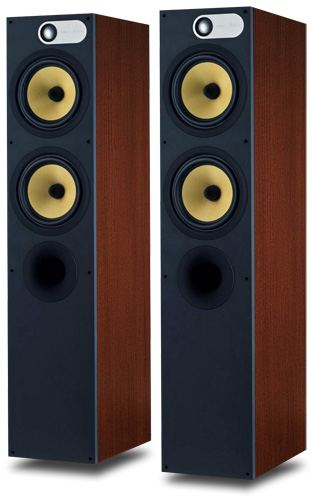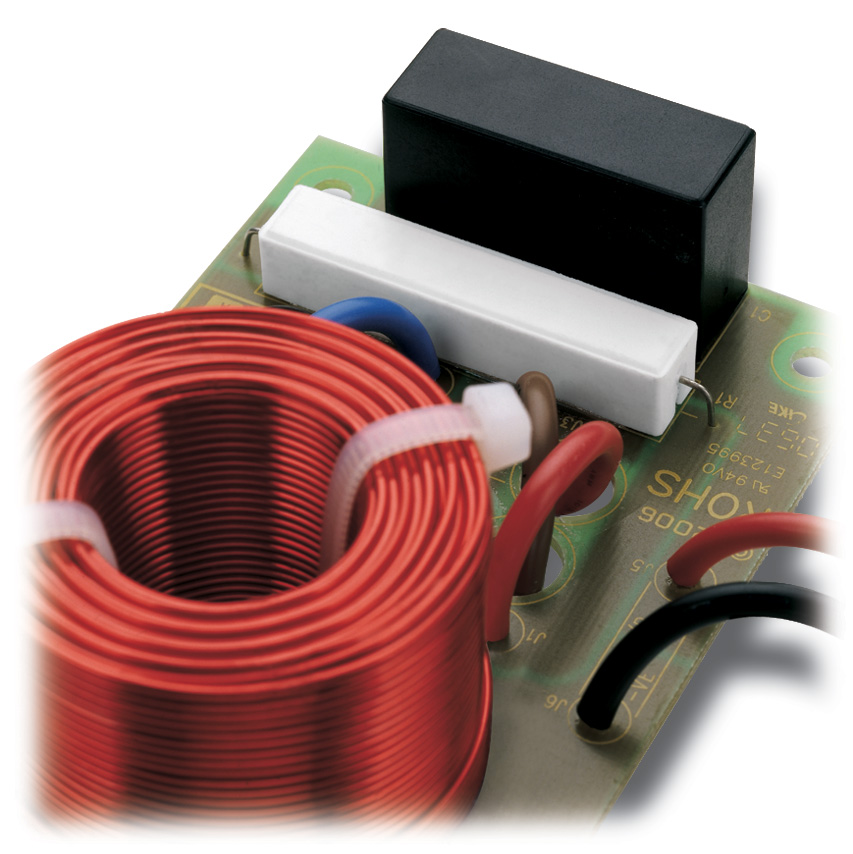 February 2010
B&W 684 Loudspeakers
  Longtime readers may be surprised to learn, as was I, which SoundStage!
loudspeaker review has been most often read and re-read in the history of the Network. It
wasn’t a review of a PSB or Paradigm speaker, or even a model from Wilson Audio
Specialties. The speaker reviewed wasn’t super- or even moderately expensive -- in
fact, Bowers and
Wilkins’ CM1 cost under $1000/pair. Longtime readers may be surprised to learn, as was I, which SoundStage!
loudspeaker review has been most often read and re-read in the history of the Network. It
wasn’t a review of a PSB or Paradigm speaker, or even a model from Wilson Audio
Specialties. The speaker reviewed wasn’t super- or even moderately expensive -- in
fact, Bowers and
Wilkins’ CM1 cost under $1000/pair.
It wasn’t the fact that it was a B&W that
surprised me. B&W has been designing speakers since the mid-1960s, its goal "to
get as close as possible to transparent reproduction of recorded sound." What did
surprise me was that the most-read SoundStage! review was of a $900 pair of bookshelf
speakers. Perhaps I sound like a snob in saying so, but that review flew right under my
radar. Evidently, more people are interested in buying affordable audio equipment
than are interested in simply reading about it.
684
The 684 ($550 USD each) is one of two floorstanding
speakers in B&W’s 600 line designed to be used in hi-fi and home-theater
systems. It’s fairly short for a floorstander: 35.8"H x 7.8"W x
11.8"D. However, when I lifted one, I could feel how substantial it is -- at 40.1
pounds, the 684 is built like a tank. Some of the weight can be attributed to the plinth
on which the speaker sits. This block, 10.125"W by 14.5"D, raises the 684 a
little over 1.5", once the spikes or rubber feet are installed. The spikes are for
carpets; the rubber-ball feet are for hardwood floors, such as mine -- I found them a nice
addition. Sitting on its plinth, the speaker was rock-steady.
The 684 has a 1" aluminum-dome tweeter, a 6.5"
midrange/woofer, and a 6.5" woofer. The latter two drive-units are made of woven
Kevlar, B&W’s cone material of choice since 1974 because it "exhibits a
peculiar style of break-up behavior, not found in more conventional materials, that
maintains a more constant dispersion pattern at all frequencies in its range and transmits
far fewer delayed, time-smearing sounds to the listener."
The 684’s crossover is a 2.5-way design. First-order
filters are used for the handoff of tweeter to midrange (at 4kHz). There is a low pass on
the bass driver (at 150Hz). This allows the 684’s midrange driver to combine with the
woofer to produce the low bass; the 684 is thus capable of being played louder and with
less distortion in the bass than a comparable two-driver loudspeaker.
There are two ports, one each on the speaker’s front
and back, the surfaces of the apertures dimpled like golf balls. B&W calls this design
Flowport; they feel the dimples reduce airflow turbulence and therefore reduce chuffing
and compression at loud volumes. Also included are two foam plugs that can be used to stop
up the ports. For example, if a speaker has to be placed far back in a corner, you may
want to plug its rear port to cut down on bass bloat. The front port can be used to
fine-tune the bass a bit more. I found the sound to be a little cleaner and tighter with
both 684s’ front ports plugged.
Each B&W 684 has two pairs of binding posts, in case
you want to biamp them. If your speaker cables are terminated in spades, make sure the
spades are wide enough (I had a bit of trouble). The 684 comes in four vinyl veneers:
Black Ash, Red Cherry, Wengé (my review samples), and Light Oak (not available in the US
or Canada).

The 684's crossover
System
I single-wired the 684s to my Classé CA-2200 power
amplifier, driven by a Simaudio Moon P5.3 preamplifier and a Bel Canto e.One DAC3 D/A
converter. The digital source was an Apple MacBook Pro running iTunes and the Amarra audio
engine. All cables were Analysis Plus.
Sound
To start things off, I listened to Alison Krauss and Robert
Plant’s Raising Sand (CD, Decca 475 938-2). Before this album’s release,
I’d seen a televised concert of its songs, and knew even then that it would be a
must-buy. This is an odd pairing of singers, to say the least, and dialing down
Plant’s performance must have been the biggest challenge facing producer T-Bone
Burnett, who described his coaching of the former Led Zeppelin singer as telling him to
"sing softer." The album went on to win a Grammy for Album of the Year for 2007.
The track I most enjoy is "Please Read the
Letter." Playing it through the B&W 684s, I was impressed with the small
speakers’ ability to create a wide soundstage on which were tightly focused images of
all the instruments. Whether it was the timpani that drives the rhythm of the song or the
guitar that follows it, each instrument’s physical outline was surrounded by ample
space and air. While the drum kit was very transparent, the two little 6.5" bass
drivers didn’t deliver each stroke with quite as visceral a reproduction as I’ve
heard through larger speakers. However, without that last bit of low-end power that larger
speakers can be capable of, I was able to concentrate a bit more on the recording’s
subtler points. All in all, the 684’s performance was well balanced and neutral
across the majority of the audioband.
To further test the 684’s bottom end, I put on another
favorite recording: "Shining Star," from Brian Bromberg’s Woods II
(CD, Artistry 757008). This song boasts three dueling acoustic bass guitars: one each in
the left, right, and center of the soundstage. Each bassist takes the lead in turn while
the other two thump a few notes in support. I was very pleased with how quick and
transparent each pluck sounded through the B&Ws. Again, the lowest points of each note
were subdued, but for the most part, the 684s nailed the reproduction. For example, while
the left and right basses were thumping their background notes, the central one was
frantically plucking away at the lead. With some larger speakers I’ve auditioned in
my room, I’ve sometimes felt that this performance can be overshadowed by too much
low-end weight. Even slight room overload can mask other frequencies. The 684s played down
to the mid-40Hz range in my room -- low enough to accurately reproduce the sound of the
bass guitar’s lowest note. Each guitar occupied a distinct space within the
soundstage and never relinquished it. The notes were full-bodied, with accurate shape and
dimensionality.
The B&W 684 really shone in the midrange. Listening to
Nick Cave’s "Into My Arms," from The Boatman’s Call (CD,
Reprise 46530), I was able to hear how sweet that Kevlar mid/woofer really is. Cave’s
strong voice, still quite delicate in this performance, is mixed very forward and
in-your-face, but despite the energy with which it filled the room, minute details were
easily discernible. Being able to listen deeper into a recording in this way is what
high-end audio is all about. A friend and I recently spoke about how, while you don’t
need a high-end stereo to enjoy music, a highly resolving stereo system can let you
more easily appreciate a great performance in a much more intimate and engaging way. I
felt this way about listening to this Nick Cave song through the 684s, and to many of the
live recordings in my collection. The sound of the piano was completely vibrant, and while
the weight of the instrument’s lower notes were fully fleshed out, Cave’s voice
didn’t overload the speaker, as I had feared it might.
When I wanted to test the B&W’s ability to handle
the upper registers of a woman’s voice, Norah Jones came to mind. I popped in her
first album, Come Away With Me (CD, Parlophone 5396092). The hit "Don’t
Know Why" is the first track, and I was immediately introduced to Jones’s sultry
voice. Her vocal range is pretty amazing, and this recording bears witness to that. In the
very first phrase she sings, the dynamic range of Jones’s voice energized the room.
While this can get dangerously close to wearing down the ears, I found her voice to be
well controlled and quite clear through the 684s -- no high-frequency smear here. Like the
other instruments, Jones’s voice occupied a distinct space, and was allowed to grow
within that space as needed. Each note of the bass guitar was articulately rendered -- no
"one-note bass." Each note had its individual pitch and was reproduced in very
linear fashion.
However, there were times when the 684’s
high-frequency reproduction seemed a bit hot, as on Sunny Sumter’s cover of Duke
Ellington and Billy Strayhorn’s "Day Dream," on Sunny (CD,
Mapleshade 5932). As I listened to this track, there were moments when Sumter’s voice
exposed the limits of the 684’s 1" aluminum tweeter -- even at moderate
listening levels, the highs were a little overbearing. B&Ws have the reputation for
being ruthlessly revealing in the highs, and with this recording the 684s revealed that
characteristic.
The B&W 684 is a very good little loudspeaker that
bears comparison with even more costly models, a great example of which is the Thiel CS1.6
-- at $1195 it costs a little over twice as much as the 684, but is similar to it in many
ways. First, both speakers are approximately the same size, with the B&W 684 having a
heftier feel. Both use first-order crossovers, and both companies pride themselves on the
proper dispersion characteristics of their speakers. Both the 684 and the CS1.6 have
metal-dome tweeters, and can be a bit bright with some recordings, with the CS1.6’s
top end being a little more extended and resolving. Both speakers were very detailed and
neutral in the midrange and played equally low in the bass, the B&Ws perhaps having
slightly more authority in my room. Both produced very wide, detailed soundstages, but the
Thiel was capable of providing sharper, more focused images. Both designs shone in terms
of overall fidelity to the source material. In short, the B&W 684 compared well to the
Thiel CS1.6 -- which makes it quite a deal at less than half the price.
Conclusion
The B&W 684 was a treat to have in my system. It was
nice to have a well-designed, very affordable speaker on hand to deflate my speaker
snobbery. The speaker’s performance as a whole surprised me, and the detailed
smoothness of its midrange wowed me. I enjoyed listening to my music through the 684s, and
appreciated their honest reproduction of each track. While the 684 will need the aid of a
subwoofer to be truly full-range, its mid-40Hz output was good enough for most recordings
out there. It was easy to drive, as hinted at by its 90dB sensitivity, so pairing it with
a good receiver or multichannel amplifier should be easy.
I now understand why the SoundStage! review of
B&W’s CM1 was so widely read. With performance like this, particularly at an
accessible price point for many consumers, B&W definitely has another winner on their
hands with the 684.
. . . Randall Smith
randalls@soundstagenetwork.com
B&W 684 Loudspeakers
Price: $1100 USD per pair.
Warranty: Three years parts and labor.B&W
Group North America
54 Concord Street
North Reading, MA 01864
Phone: (978) 664-2870
Fax: (978) 664-4109
E-mail: marketing@bwgroupusa.com
Website: www.bowers-wilkins.com
|
|

